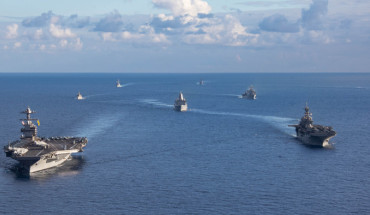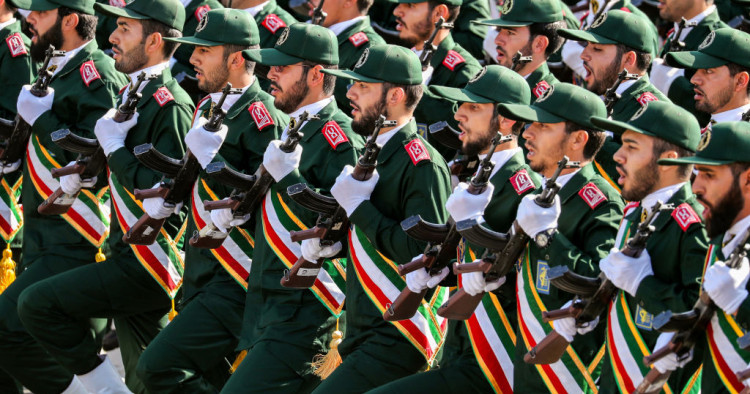This month marks the 45th anniversary of the founding of Iran’s Islamic Revolutionary Guard Corps (IRGC). Mohsen Sazegara, a non-resident scholar with MEI’s Iran Program, was one of the group’s founders and a member of its first board of commanders. He later became a journalist and a reformist political activist. He was arrested and imprisoned four times before ultimately leaving Iran. He was interviewed by MEI in early May and the below text has been edited lightly for clarity.
When was the idea of creating the IRGC first conceived and how did it come about?
Sazegara: In 1975, I came to the United States to continue my studies. I joined the Muslim Students Association (MSA) and the Liberation Movement of Iran (LMI). The LMI was a political organization headed by Mehdi Bazargan, who later became the first prime minister of the Islamic Republic. The organization was outlawed inside Iran but was covertly organized outside the country. By the order of the LMI, I was tasked with studying various voluntary armies, like the Israeli and Swiss armies, as well as the US National Guard and the people’s armies in existence at the time, like the Viet Cong and Algeria’s National Liberation Front. With the rise of the Islamic Revolution and Ayatollah Ruhollah Khomeini's transfer to France, I went to France and joined Khomeini's team. During his hundred-day stay in Neauphle-le-Château, I pursued the idea of forming a popular army after a suggestion by Ebrahim Yazdi, one of the leaders of the LMI outside the country and the top advisor to Khomeini.
The thinking was that we would be facing a protracted war against the shah's regime and its main supporter, the United States, similar to the Vietnam War. However, the Islamic Revolution triumphed dramatically and unexpectedly less than four months after Khomeini’s transfer to France, relying on nonviolent civil resistance methods. I returned to Iran on the same Air France flight with Khomeini and his other advisors.
The project of forming a people’s army to liberate Iran soon turned into forming a people’s army to preserve the country's security and territorial integrity while defending the new regime against a possible American coup to return the shah to power.
Were countries in the Soviet bloc involved at all?
Sazegara: No, not at all. During that time, we, as nationalists and Muslim activists, were as opposed to the Soviet Union as we were to the US. Furthermore, we considered the communists to be our political rivals.
What sort of factions were there within the IRGC in the early days?
Sazegara: During its first three months, when I served in the Revolutionary Guards, political factionalism and polarization had not yet taken shape. Outside the IRGC, however, tensions within the Revolutionary Council and opposition to Bazargan's government by the clerics of the Council, had begun. Some of the opponents considered themselves more revolutionary than Bazargan, his government, and the LMI.
Many initial members of the IRGC were anti-American leftists who subsequently became Islamists. How did that process of political transformation play out?
Sazegara: Among the members of the first board of commanders, of which I was also a member, and of the more than 100 individuals who joined the IRGC in those early months, no one had a leftist background. On the contrary, as I mentioned already, we nationalist and Muslim fighters fiercely competed with the communists, considering them, and the Soviet Union, as enemies and as dangerous as the US.
What were Ayatollah Khomeini’s initial views on IRGC and the role of armed non-clerics as his protectors?
Sazegara: The IRGC was set up immediately after the victory of the revolution, and Khomeini was not informed about its formation until April 3 — nearly two months after the victory of the revolution — when I, along other members of the board of commanders, went to Qom to visit him and explained to him that we had established the organization. He was very pleased and gave his strong support and prayers for its success.
What about Ayatollah Khamenei? How has his handling of the IRGC differed from that of Khomeini?
Sazegara: When Ali Khamenei became the leader, the eight-year Iran-Iraq war had already ended and the IRGC had grown into a large organization during that period, essentially becoming a parallel army that Khamenei needed to preserve his regime.
Khamenei wanted to control the IRGC and all of the other military and paramilitary forces and security services under his own command. He tried to transform the IRGC into an organization that would perform the combined tasks of groups like the Soviet Communist Party, the KGB, as well as the Nazi SS, under his personal command.
How would you describe the evolution of the IRGC over the past 45 years in terms of major phases?
Sazegara: The IRGC has deviated from its initial idea of being a people’s army with a small and committed cadre of young revolutionaries who volunteered to defend the country alongside the regular military, and it has undergone three evolutionary stages:
-
First: During the eight years of the Iran-Iraq War, the IRGC expanded under its commanders, like Mohsen Rezaee, and started to resemble the regular military (Artesh)in the way it was organized. It even went beyond organizing into three branches (ground, naval, and air forces)like the regular army and added the Quds Force and Basij under its command.
-
Second: After the war, the IRGC ventured into economic and business activities, quickly becoming involved in mafia-like operations, doing business as an armed group.
-
Third: Khamenei involved the IRGC in political activities as a force against the country’s reform movement.
Currently, the IRGC has become a multi-headed dragon.
Is the IRGC’s regional agenda its riskiest policy today? In your view, how likely is it to represent a danger to the stability of the regime?
Sazegara: Currently, the Iranian regime is essentially a consortium of corrupt economic-mafia bands, with the IRGC being a part of it. Its Quds Force operates externally in collaboration with the Lebanese Hezbollah, the Yemeni Houthis, the Iraqi Shi’a militia groups, and a number of terrorist groups inside Syria.
The Quds Force has gone beyond terrorist operations and now it leads a large network of illicit trafficking worldwide, collaborating with the Russian cartels. Its commander is directly under the supervision of the Supreme Leader. The Quds Force’s destabilizing operations in the region can isolate the regime in the international arena, and in long term that would be a threat to the stability of the regime itself.
The first generation of IRGC leaders will likely be leaving the stage soon. How do you perceive the second generation of leaders and what is their agenda for the future?
Sazegara: At the level of the commanders, the only ones from the first generation still remaining are those that are complicit and associated with the existing mafia corruption. These commanders are promoting individuals who are like themselves. However, at the grassroots level, like many ordinary people, the younger recruits are deeply dissatisfied and have ideological misgivings and livelihood problems. This is a serious and problematic trend for the IRGC.
Among the foreign powers, does Russia have the greatest influence today when it comes to the IRGC’s agenda?
Sazegara: Yes, Russia has the greatest influence in the IRGC, the intelligence apparatus, and the Office of the Supreme Leader.
The IRGC has regional and other splits within its rank. How would you describe these splits and what impact do they have on the organization and its operations?
Sazegara: Answering this question properly would require another interview and an explanation of the seven heads of the IRGC dragon.
The IRGC’s motto is that, “If there is no IRGC, there is no Iran.” What is the public perception of the IRGC in Iran today? To what extent are they seen as responsible for the problems with Iran’s economy, its international isolation, and domestic political repression?
Sazegara: In recent years, following the massacre of people in November 2019 and the brutal suppression in the Mahsa Amini revolution in 2022, the IRGC has become deeply detested among the people, who consider it as the backbone of regime’s corruption and crimes.
Photo by STRINGER/AFP/Getty Images
The Middle East Institute (MEI) is an independent, non-partisan, non-for-profit, educational organization. It does not engage in advocacy and its scholars’ opinions are their own. MEI welcomes financial donations, but retains sole editorial control over its work and its publications reflect only the authors’ views. For a listing of MEI donors, please click here.













